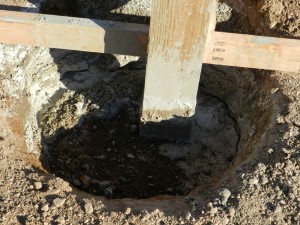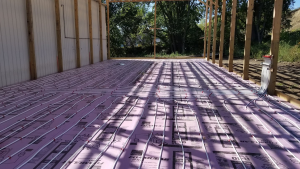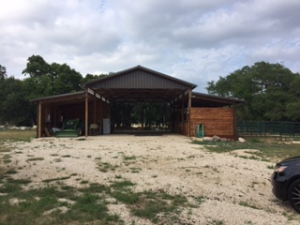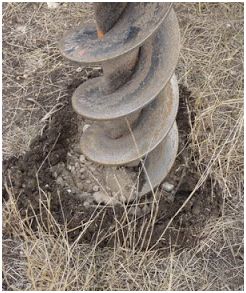Welcome to Ask the Pole Barn Guru – where you can ask questions about building topics, with answers posted on Mondays. With many questions to answer, please be patient to watch for yours to come up on a future Monday segment. If you want a quick answer, please be sure to answer with a “reply-able” email address.
Email all questions to: PoleBarnGuru@HansenPoleBuildings.com
DEAR POLE BARN GURU: Just one question…for now… the difference in the 11,000 price and the 43,000 price is just the building plans/instructions? SARAH from anywhere USA
DEAR SARAH: I have to admit, this question on your pol barn quote had me initially stumped, until I looked back at the history of quotes you had received from us.
Back in 2011, you asked for a quote on a fully enclosed 60’ x 120’ x 12’ building, with a 12’ wide roof only shed along one side. This pole barn quote included features like a 3’ wide insulated commercial steel entry door, with factory painted steel jambs; a 12’ wide x 11’ tall all metal framed sliding door; polycarbonate eave lights on both 120’ sidewalls; a polycarbonate vented ridge; and roof insulation.
Recently, you asked for a new pole barn quote for a roof only 40’ x 60’ x 12’ building, with a 12’ wide roof only shed along one side. The only other features were the vented ridge and a cupola.
Your first quote was three times the square footage, included a sliding door, eavelights, poly ridge vent and roof insulation….and all sides of the main building were fully sheeted with steel, fully trimmed out.
This is a lesson in why trying to compare price only, ends up being nothing short of confusing for all involved.
For you, or any client, we will happily compare any quotes, to make sure all is apples-to-apples.
DEAR POLE BARN GURU: I have a client looking at a large shop building with a 30 wide 80 long side shed ( 4-12 pitch) that he intends to use for living quarters, BUT…He would like to have some kind of vaulted roof in the side shed. I currently have the shed with shed trusses, so two questions: Can we get scissor shed trusses that may be have a 2-12 interior pitch? How would we recommend that he insulate the roof of the side shed? Do you have any alternate ideas on getting some kind of vaulted ceiling in the living quarters? The building has a 20 psf flat roof snow load. RESEARCHING RICK
DEAR RESEARCING: With the relatively low roof load, you could monopitch scissor truss the side shed, but will probably get a maximum of 1.5/12 slope, unless your client can stand a parallel chord truss which would be about 3 feet deep. If so, then he could have 4/12 slope inside and outside.
With trussed vaulted ceilings, placing unfaced insulation batts between the ceiling joists will be the most effective method of insulating.
DEAR POLE BARN GURU: Couple of things I’m seeing that I thought was taboo in building a pole building- concrete filling the post holes !!! The pole barn I built 12 yrs ago, and am currently using, I back filled the holes with sand so it wouldn’t heave during winter. Second is my concern with post load using the double trusses on sandy soil with 12 ‘ centers. My current barn (different locations) uses 24″ centers in hard clay. Just a couple things of interest there. Thank you. MOPAR MIKE
DEAR MOPAR: Good questions. And can be addressed with several answers.
First – what is it the embedment of the column really has to do? It must resist uplift, overturning and settling.
These factors are addressed more thoroughly here: https://www.hansenpolebuildings.com/blog/2013/02/concrete-pier/
Next – there is absolutely nothing wrong with properly pressure preservative treated wood in contact with concrete. In fact, the Building Codes require it!
Find about more on this subject at:
https://www.hansenpolebuildings.com/blog/2013/03/footing-2/
Filling holes with sand is not going to prevent frost heave – the sand provides no resistance to heaving.
To read how to prevent frost heave: https://www.hansenpolebuildings.com/blog/2011/10/preventing_frost_heaves_in_pole_building_construction/
The sand also does nothing to address the crucial issue of uplift (the building wanting to be sucked out of the ground).
Here is some “in depth” (yes pun intended) reading on preventing uplift in pole buildings:
https://www.hansenpolebuildings.com/blog/2012/02/concrete-collars/
As to your second concern, you take the load and divide it out across the roof area. I am guessing your posts are not every 24”, but rather the trusses. Whether you have single or double trusses – it ALL gets transferred into the number of posts at whatever spacing you have and then down into the ground. Regardless of how the trusses and posts are spaced, you need a concrete footing large enough to distribute the load. I am not talking about concrete cookies, which I talk about in older blogs. What I am referring to is a monolithic concrete collar around every post designed to support the loads.
As to your concern about the roof loads being transferred through the columns and into the ground adequately – regardless of how the trusses are spaced, the columns carry the roof’s live and dead loads, multiplied by one-half of the truss span (plus any overhangs), times one-half of the distance to the next adjacent columns (in both directions).
Here is a very good article which explains more thoroughly how this works:
https://www.hansenpolebuildings.com/blog/2013/03/footing-2/
DEAR POLE BARN GURU: Do wind braces help support the horizontal beam that they are connected to? CHILLIN’ IN CHOKOLOSKEE
DEAR CHILLIN’: I am going to take a stab at your reference being to knee braces supporting roof trusses, as this would be the most likely answer.
If this is the case, then I would recommend reading this article: https://www.hansenpolebuildings.com/blog/2012/01/post-frame-construction-knee-braces/
In the case of an angle brace supporting any other horizontal member, the greatest dictate as to if it is effective or not is typically the adequacy of the connections. In most cases, the brace ends up being a waste of time and materials.
DEAR POLE BARN GURU: What is the thickness of your exterior steel? CLICKING IN CLINTON
DEAR CLICKING: Most of those who invest in new Hansen Pole Buildings chose 29 gauge steel for their siding and roofing, however there are some who prefer to use 26 gauge. We offer the flexibility for people to select what best meets their needs. For more information on steel gauges and thickness please read: https://www.hansenpolebuildings.com/blog/2012/01/steel-thickness/ and https://www.hansenpolebuildings.com/blog/2013/10/steel-thickness-4/
 DEAR DIGGING: If you think about it, a sonotube filled with concrete and a bracket on top, is going to provide less lateral resistance than a column in a hole filled with concrete. Depending upon building dimensions, exposure to wind and soil conditions above the bedrock, it is very possible increasing hole diameter and using a complete concrete encasement could do the trick.
DEAR DIGGING: If you think about it, a sonotube filled with concrete and a bracket on top, is going to provide less lateral resistance than a column in a hole filled with concrete. Depending upon building dimensions, exposure to wind and soil conditions above the bedrock, it is very possible increasing hole diameter and using a complete concrete encasement could do the trick. I found it strange – no posts were set on the front endwall of the building until after the balance of the building had been pretty much framed up. When those pole barn holes were dug, I watched as one of the crew members climbed into an overlarge hole to place a post. The hole could not possibly have been three feet deep! So much for frost issues. If you remember from yesterday – the frost depth here is 5 feet. They were only about 2’ short.
I found it strange – no posts were set on the front endwall of the building until after the balance of the building had been pretty much framed up. When those pole barn holes were dug, I watched as one of the crew members climbed into an overlarge hole to place a post. The hole could not possibly have been three feet deep! So much for frost issues. If you remember from yesterday – the frost depth here is 5 feet. They were only about 2’ short. “I looked at each of the suppliers of pole frame kits and was not impressed with the cookie base with treated pole foundation. I only found one that included a preformed concrete pillar with a top flange. I like this system. A little more labor and a wee bit more concrete but it seems to make for a better quality foundation. Whaddya think?”
“I looked at each of the suppliers of pole frame kits and was not impressed with the cookie base with treated pole foundation. I only found one that included a preformed concrete pillar with a top flange. I like this system. A little more labor and a wee bit more concrete but it seems to make for a better quality foundation. Whaddya think?” In my case, we had contracted to build a 36 foot wide by 60 foot long horse stall barn – so there was a plethora of holes to be dug. Depending upon which hole we were at, 12 to 18 inches below the surface we hit a huge shelf of granite. Under the entire building!
In my case, we had contracted to build a 36 foot wide by 60 foot long horse stall barn – so there was a plethora of holes to be dug. Depending upon which hole we were at, 12 to 18 inches below the surface we hit a huge shelf of granite. Under the entire building!






